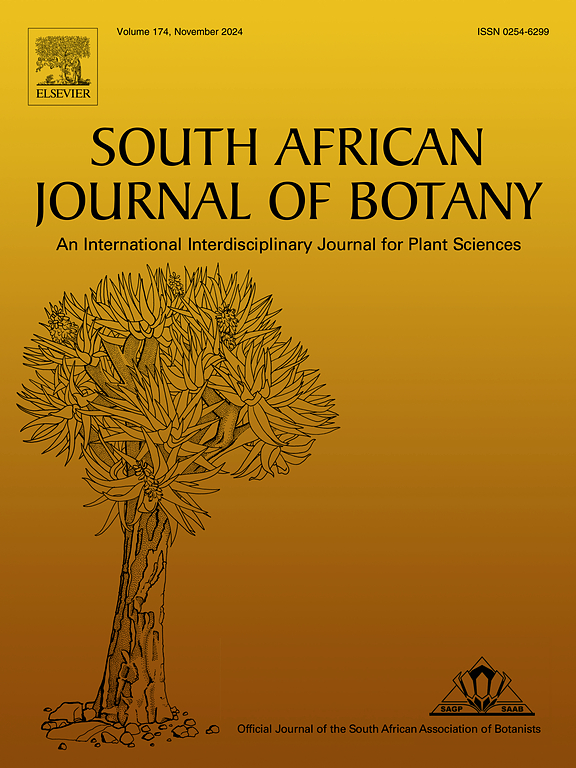从药用植物中分离的抗真菌化合物:南非综合综述
IF 2.7
3区 生物学
Q2 PLANT SCIENCES
引用次数: 0
摘要
目前的综述旨在记录抗分枝杆菌化合物和衍生物对抗过多的致病性和非致病性分枝杆菌。在南非,不同种族的土著人使用药用植物来治疗各种分枝杆菌感染。然而,其有效成分、作用方式和安全性并不为这些外行人所知。从24个不同科的35种药用植物中分离、鉴定和合成了117个抗真菌化合物。菊科(20.83%)次之,combretacae(16.67%)次之,Lamiaceae(12.5%)、malvacae(8.33%)、rutacae(8.33%)次之。其中以萘醌类(22.22%)、黄酮类(19.66%)、三萜(14.53%)、萜烯类(10.26%)、甾体和糖苷类(7.69%)和香豆素类(5.13%)居多。萘醌类化合物得到了很好的研究,7-甲基核桃苷酮和山芦酮等化合物对结核分枝杆菌和牛分枝杆菌的MIC值分别为0.50和3.74µg/ml。几种化合物对药物敏感型和耐药型结核分枝杆菌均显示出有效的抗细菌活性。然而,在目前的论文中记录的许多抗真菌化合物的毒理学和作用方式仍未被探索。体内研究和临床试验仍然滞后,这使得抗细菌研究不太可能在制药工业中产生可能的抗细菌药物,从而减轻卫生部门内现成抗生素的抗微生物压力。然而,所报道的来自各种药用植物的化合物的体外生物活性可作为根除世界范围内各种人类和动物分枝杆菌感染的第一步。本文章由计算机程序翻译,如有差异,请以英文原文为准。

Antimycobacterial compounds isolated from medicinal plants: A South African comprehensive review
The current review aims at documenting the antimycobacterial compounds and derivatives against a plethora of pathogenic and non-pathogenic Mycobacteria. In South Africa, the indigenous people of different ethnic groups use medicinal plants to treat various Mycobacterial infections. However, the active ingredients, mode of action and safety profiles are not known to such lay people. A total of 117 antimycobacterial compounds were isolated, characterised, and synthesised from 35 medicinal plants belonging to 24 different families. The most dominant family was Asteraceae (20.83 %), followed by Combretaceae (16.67 %), and then Lamiaceae (12.5 %), Malvaceae and Rutaceae with 8.33 % apiece. The diversity of such compounds favoured the naphthoquinones (22.22 %), flavonoids (19.66 %), triterpenes (14.53 %), terpenes (10.26 %), steroids and glycosides (7.69 %), and coumarins (5.13 %). Naphthoquinones are well studies and compounds such as 7-methyljuglone and shinanolone from Euclea natalensis exhibited notable MIC values as low as 0.50 and 3.74 µg/ml against Mycobacterium tuberculosis and Mycobacterium bovis respectively. Several compounds showed potent antimycobacterial activity against both drug-sensitive and drug resistant strains of Mycobacterium tuberculosis. However, the toxicology and mode of action of many of the antimycobacterial compounds documented in the current paper remains unexplored. The in vivo studies and clinical trials are still lagging, making the antimycobacterial research less likely to yield possible antimycobacterial drugs in the pharmaceutical industry, alleviating antimicrobial pressure of the readily available antibiotics within the health sector. However, the in vitro bioactivity of the reported compounds from various medicinal plants serves as a first step towards eradicating various human and animal mycobacterial infections worldwide.
求助全文
通过发布文献求助,成功后即可免费获取论文全文。
去求助
来源期刊

South African Journal of Botany
生物-植物科学
CiteScore
5.20
自引率
9.70%
发文量
709
审稿时长
61 days
期刊介绍:
The South African Journal of Botany publishes original papers that deal with the classification, biodiversity, morphology, physiology, molecular biology, ecology, biotechnology, ethnobotany and other botanically related aspects of species that are of importance to southern Africa. Manuscripts dealing with significant new findings on other species of the world and general botanical principles will also be considered and are encouraged.
 求助内容:
求助内容: 应助结果提醒方式:
应助结果提醒方式:


